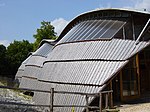Singleton, West Sussex
Chichester DistrictVillages in West Sussex

Singleton is a village, Anglican parish and civil parish in the Chichester district of West Sussex, England. It lies in the Lavant valley, 5 miles (8 km) miles north of Chichester on the A286 road to Midhurst. The civil parish has a land area of 1,602 hectares (3,960 acres). In the 2001 census there were 199 households containing 476 people, of whom 199 were economically active. The population marginally increased to 480 at the 2011 Census.
Excerpt from the Wikipedia article Singleton, West Sussex (License: CC BY-SA 3.0, Authors, Images).Singleton, West Sussex
Papageienbrücke, Hannover Calenberger Neustadt (Südstadt-Bult)
Geographical coordinates (GPS) Address Nearby Places Show on map
Geographical coordinates (GPS)
| Latitude | Longitude |
|---|---|
| N 50.91066 ° | E -0.75313 ° |
Address
Papageienbrücke
Papageienbrücke
30169 Hannover, Calenberger Neustadt (Südstadt-Bult)
Niedersachsen, Deutschland
Open on Google Maps









